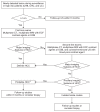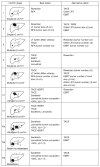2018 Korean Liver Cancer Association-National Cancer Center Korea Practice Guidelines for the Management of Hepatocellular Carcinoma
- PMID: 31060120
- PMCID: PMC6529163
- DOI: 10.5009/gnl19024
2018 Korean Liver Cancer Association-National Cancer Center Korea Practice Guidelines for the Management of Hepatocellular Carcinoma
Abstract
Hepatocellular carcinoma (HCC) is the fifth most common cancer globally and the fourth most common cancer in men in Korea, where the prevalence of chronic hepatitis B infection is high in middle-aged and elderly patients. These practice guidelines will provide useful and constructive advice for the clinical management of patients with HCC. A total of 44 experts in hepatology, oncology, surgery, radiology and radiation oncology in the Korean Liver Cancer Association-National Cancer Center Korea Practice Guideline Revision Committee revised the 2014 Korean guidelines and developed new recommendations that integrate the most up-to-date research findings and expert opinions.
Keywords: Carcinoma; Diagnosis; Guidelines; Management; hepatocellular.
Conflict of interest statement
Conflicts of interests among the members are summarized in Appendix 1.
Figures





References
-
- Guyatt GH, Oxman AD, Vist GE, et al. GRADE: an emerging consensus on rating quality of evidence and strength of recommendations. BMJ. 2008;336:924–926. doi: 10.1136/bmj.39489.470347.AD. - DOI - PMC - PubMed
-
- Guyatt GH, Oxman AD, Kunz R, et al. What is “quality of evidence” and why is it important to clinicians? BMJ. 2008;336:995–998. doi: 10.1136/bmj.39490.551019.BE. - DOI - PMC - PubMed
-
- Guyatt GH, Oxman AD, Kunz R, et al. Going from evidence to recommendations. BMJ. 2008;336:1049–1051. doi: 10.1136/bmj.39493.646875.AE. - DOI - PMC - PubMed
-
- Schunemann HJ, Oxman AD, Brozek J, et al. Grading quality of evidence and strength of recommendations for diagnostic tests and strategies. BMJ. 2008;336:1106–1110. doi: 10.1136/bmj.39500.677199.AE. - DOI - PMC - PubMed
Publication types
MeSH terms
LinkOut - more resources
Full Text Sources
Medical

